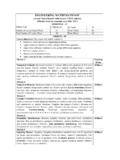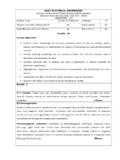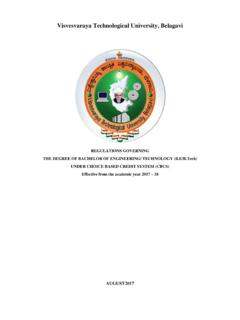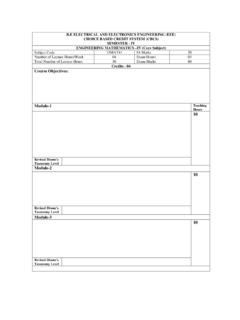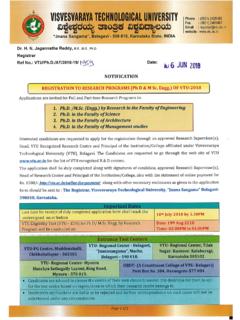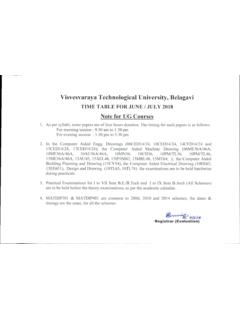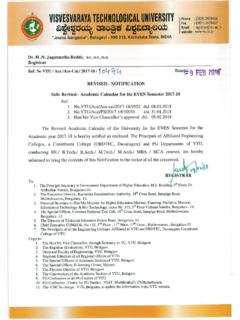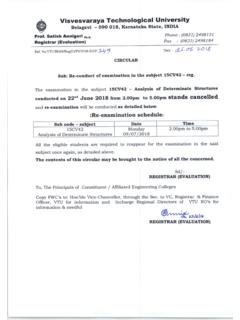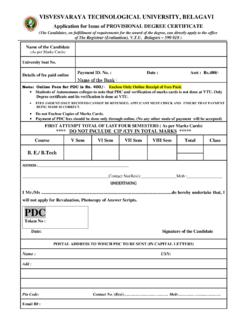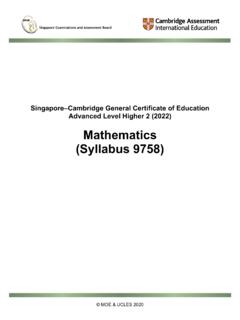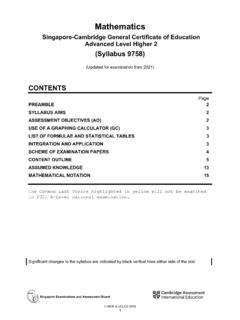Transcription of ENGINEERING MATHEMATICS-III
1 ENGINEERING MATHEMATICS-III [As per Choice based Credit System (CBCS) scheme] (Effective from the academic year 2017 -2018) SEMESTER III Subject Code 17 MAT31 IA Marks 40 Number of Lecture Hours/Week 04 Exam Marks 60 Total Number of Lecture Hours 50 Exam Hours 03 CREDITS 04 Module -1 Teaching Hours Fourier Series: Periodic functions, Dirichlet s condition, Fourier Series of periodic functions with period 2 and with arbitrary period 2c. Fourier series of even and odd functions. Half range Fourier Series, practical harmonic analysis-Illustrative examples from ENGINEERING field. 10 Hours Module -2 Fourier Transforms: Infinite Fourier transforms, Fourier sine and cosine transforms. Inverse Fourier transform. Z-transform: Difference equations, basic definition, z-transform-definition, Standard z-transforms, Damping rule, Shifting rule, Initial value and final value theorems (without proof) and problems, Inverse z-transform. Applications of z-transforms to solve difference equations.
2 10 Hours Module 3 Statistical Methods: Review of measures of central tendency and dispersion. Correlation-Karl Pearson s coefficient of correlation-problems. Regression analysis- lines of regression (without proof) problems Curve Fitting: Curve fitting by the method of least squares- fitting of the curves of the form, y = ax + b, y = ax2 + bx + c and y = aebx. Numerical Methods: Numerical solution of algebraic and transcendental equations by Regula- Falsi Method and Newton-Raphson method. 10 Hours Module-4 Finite differences: Forward and backward differences, Newton s forward and backward interpolation formulae. Divided differences- Newton s divided difference formula. Lagrange s interpolation formula and inverse interpolation formula (all formulae without proof)-Problems. Numerical integration: Simpson s (1/3)th and (3/8)th rules, Weddle s rule (without proof ) Problems. 10 Hours Module-5 Vector integration: Line integrals-definition and problems, surface and volume integrals-definition, Green s theorem in a plane, Stokes and Gauss-divergence theorem(without proof) and problems.
3 Calculus of Variations: Variation of function and Functional, variational problems. Euler s equation, Geodesics, hanging chain, problems. 10 Hours Course outcomes: After Studying this course, students will be able to Know the use of periodic signals and Fourier series to analyze circuits and system communications. Explain the general linear system theory for continuous-time signals and digital signal processing using the Fourier Transform and z-transform. Employ appropriate numerical methods to solve algebraic and transcendental equations. Apply Green's Theorem, Divergence Theorem and Stokes' theorem in various applications in the field of electro-magnetic and gravitational fields and fluid flow problems. Determine the extremals of functionals and solve the simple problems of the calculus of variations. Question paper pattern: The question paper will have ten questions. There will be 2 questions from each module. Each question will have questions covering all the topics under a module.
4 The students will have to answer 5 full questions, selecting one full question from each module. Text Books: 1. B. S. Grewal," Higher ENGINEERING mathematics ", Khanna publishers, 42nd edition, 2013. 2. Ramana "Higher ENGINEERING mathematics " Tata McGraw-Hill, 2006. Reference Books: 1. N. P. Bali and Manish Goyal, "A text book of ENGINEERING mathematics " , Laxmi publications, latest edition. 2. Kreyszig, "Advanced ENGINEERING mathematics " - 9th edition, Wiley. 3. H. K Dass and Er. Rajnish Verma ,"Higher ENGINEERING mathematics ", S. Chand, 1st ed. ANALOG AND DIGITAL ELECTRONICS [As per Choice based Credit System (CBCS) scheme] (Effective from the academic year 2017 -2018) SEMESTER - III Subject Code 17CS32 IA Marks 40 Number of Lecture Hours/Week 04 Exam Marks 60 Total Number of Lecture Hours 50 Exam Hours 03 CREDITS 04 Module -1 Teaching Hours Field Effect Transistors: Junction Field Effect Transistors, MOSFETs, Differences between JFETs and MOSFETs, Biasing MOSFETs, FET Applications, CMOS Devices.
5 Wave-Shaping Circuits: Integrated Circuit(IC) Multivibrators. Introduction to Operational Amplifier: Ideal v/s practical Opamp, Performance Parameters, Operational Amplifier Application Circuits:Peak Detector Circuit, Comparator, Active Filters, Non-Linear Amplifier, Relaxation Oscillator, Current-To-Voltage Converter, Voltage-To-Current Converter. Text book 1:- Ch5: , , , , , : 16: , Ch 17: , , , , , , ) 10 Hours Module -2 The Basic Gates: Review of Basic Logic gates, Positive and Negative Logic, Introduction to HDL. Combinational Logic Circuits: Sum-of-Products Method, Truth Table to Karnaugh Map, Pairs Quads, and Octets, Karnaugh Simplifications, Don t-care Conditions, Product-of-sums Method, Product-of-sums simplifications, Simplification by Quine-McClusky Method, Hazards and Hazard covers, HDL Implementation Models. Text book 2:- Ch2: , Ch3: to 10 Hours Module 3 Data-Processing Circuits: Multiplexers, Demultiplexers, 1-of-16 Decoder, BCD to Decimal Decoders, Seven Segment Decoders, Encoders, Exclusive-OR Gates, Parity Generators and Checkers, Magnitude Comparator, Programmable Array Logic, Programmable Logic Arrays, HDL Implementation of Data Processing Circuits.
6 Arithmetic Building Blocks, Arithmetic Logic Unit Flip- Flops: RS Flip-Flops, Gated Flip-Flops, Edge-triggered RS FLIP-FLOP, Edge-triggered D FLIP-FLOPs, Edge-triggered JK FLIP-FLOPs. Text book 2:- Ch 4:- to , , , , :- to 10 Hours Module-4 Flip- Flops: FLIP-FLOP Timing, JK Master-slave FLIP-FLOP, Switch Contact Bounce Circuits, Various Representation of FLIP-FLOPs, HDL Implementation of FLIP-FLOP. Registers: Types of Registers, Serial In - Serial Out, Serial In - Parallel out, Parallel In - Serial Out, Parallel In - Parallel Out, Universal Shift Register, Applications of Shift Registers, Register implementation in HDL. Counters: Asynchronous Counters, Decoding Gates, Synchronous Counters, Changing the Counter Modulus. (Text book 2:- Ch 8: , , , , Ch 9: to Ch 10: to ) 10 Hours Module-5 Counters: Decade Counters, Presettable Counters, Counter Design as a Synthesis problem , A Digital Clock, Counter Design using HDL.
7 D/A Conversion and A/D Conversion: Variable, Resistor Networks, Binary Ladders, D/A Converters, D/A Accuracy and Resolution, A/D Converter-Simultaneous Conversion, A/D Converter-Counter Method, Continuous A/D Conversion, A/D Techniques, Dual-slope A/D Conversion, A/D Accuracy and Resolution. Text book 2:- Ch 10: to Ch 12: to 10 Hours Course outcomes: After Studying this course, students will be able to Explain the operation of JFETs and MOSFETs , Operational Amplifier circuits and their application Explain Combinational Logic, Simplification Techniques using Karnaugh Maps, Quine McClusky technique. Demonstrate Operation of Decoders, Encoders, Multiplexers, Adders and Subtractors, working of Latches, Flip-Flops, Designing Registers, Counters, A/D and D/A Converters Design of Counters, Registers and A/D & D/A converters Question paper pattern: The question paper will have ten questions. There will be 2 questions from each module.
8 Each question will have questions covering all the topics under a module. The students will have to answer 5 full questions, selecting one full question from each module. Text Books: 1. Anil K Maini, Varsha Agarwal: Electronic Devices and Circuits, Wiley, 2012. 2. Donald P Leach, Albert Paul Malvino & Goutam Saha: Digital Principles and Applications, 8th Edition, Tata McGraw Hill, 2015 Reference Books: 1. Stephen Brown, Zvonko Vranesic: Fundamentals of Digital Logic Design with VHDL, 2nd Edition, Tata McGraw Hill, 2005. 2. R D Sudhaker Samuel: Illustrative Approach to Logic Design, Sanguine-Pearson, 2010. 3. M Morris Mano: Digital Logic and computer Design, 10th Edition, Pearson, 2008. DATA STRUCTURES AND APPLICATIONS [As per Choice based Credit System (CBCS) scheme] (Effective from the academic year 2017 -2018) SEMESTER - III Subject Code 17CS33 IA Marks 40 Number of Lecture Hours/Week 04 Exam Marks 60 Total Number of Lecture Hours 50 Exam Hours 03 CREDITS - 04 Module -1 Teaching Hours Introduction: Data Structures, Classifications (Primitive & Non Primitive), Data structure Operations, Review of Arrays, Structures, Self-Referential Structures, and Unions.
9 Pointers and Dynamic Memory Allocation Functions. Representation of Linear Arrays in Memory, Dynamically allocated arrays, Array Operations: Traversing, inserting, deleting, searching, and sorting. Multidimensional Arrays, Polynomials and Sparse Matrices. Strings: Basic Terminology, Storing, Operations and Pattern Matching algorithms. Programming Examples. Text 1: Ch 1: , Ch2: Text 2: Ch 1: , Ch 3: , , , Ch 4: , Ref 3: Ch 1: 10 Hours Module -2 Stacks and Queues Stacks: Definition, Stack Operations, Array Representation of Stacks, Stacks using Dynamic Arrays, Stack Applications: Polish notation, Infix to postfix conversion, evaluation of postfix expression, Recursion - Factorial, GCD, Fibonacci Sequence, Tower of Hanoi, Ackerman's function. Queues: Definition, Array Representation, Queue Operations, Circular Queues, Circular queues using Dynamic arrays, Dequeues, Priority Queues, A Mazing problem . Multiple Stacks and Queues.
10 Programming Examples. Text 1: Ch3: Text 2: Ch6: , , , , 10 Hours Module 3 Linked Lists: Definition, Representation of linked lists in Memory, Memory allocation; Garbage Collection. Linked list operations: Traversing, Searching, Insertion, and Deletion. Doubly Linked lists, Circular linked lists, and header linked lists. Linked Stacks and Queues. Applications of Linked lists Polynomials, Sparse matrix representation. Programming Examples Text 1: Ch4: except Text 2: Ch5: 10 Hours Module-4 Trees: Terminology, Binary Trees, Properties of Binary trees, Array and linked Representation of Binary Trees, Binary Tree Traversals - Inorder, postorder, preorder; Additional Binary tree operations. Threaded binary trees, Binary Search Trees Definition, Insertion, Deletion, Traversal, Searching, Application of Trees-Evaluation of Expression, Programming Examples Text 1: Ch5: , Text 2: Ch7: 10 Hours Module-5 Graphs: Definitions, Terminologies, Matrix and Adjacency List Representation Of Graphs, Elementary Graph operations, Traversal methods: Breadth First Search and Depth First Search.
